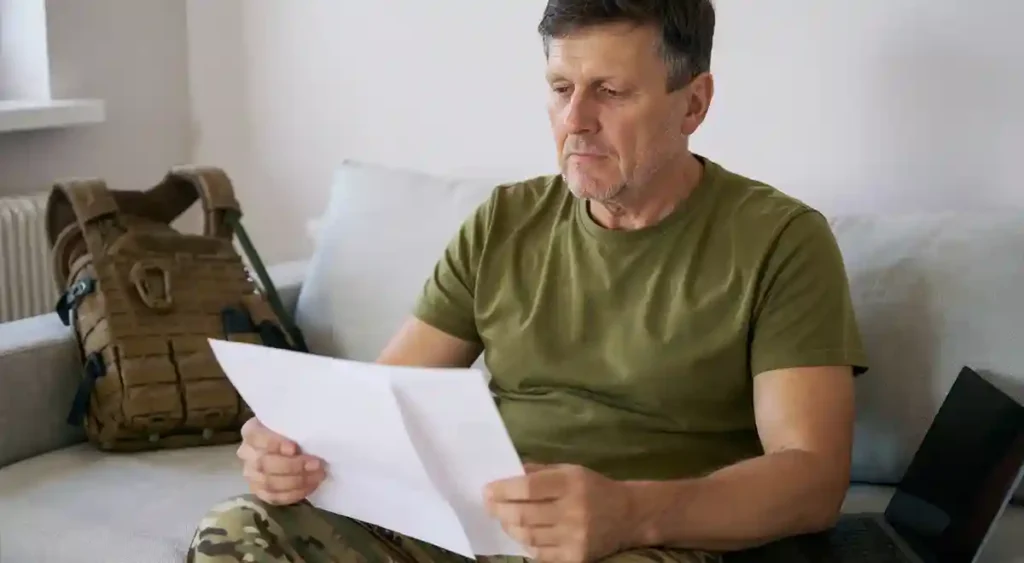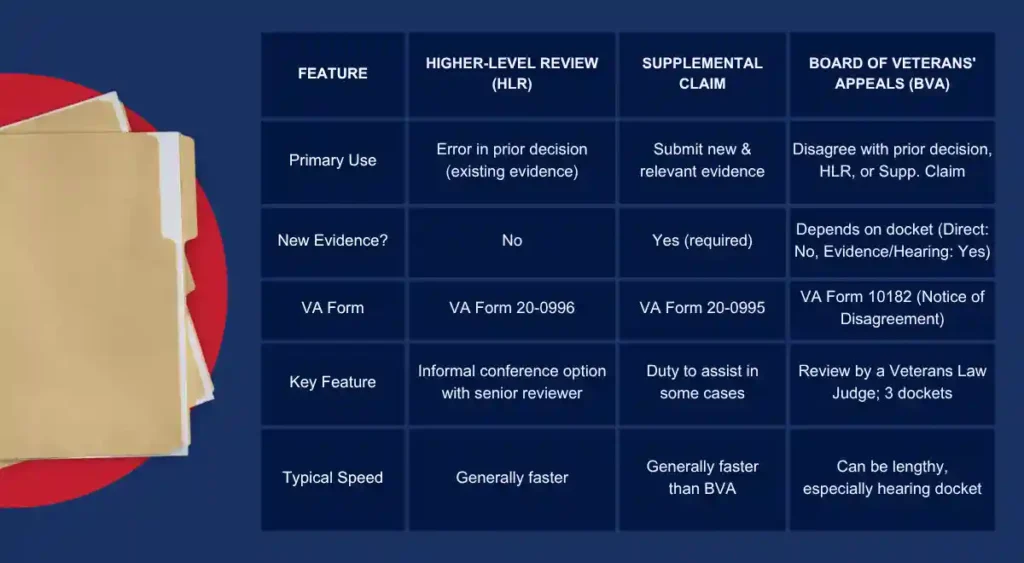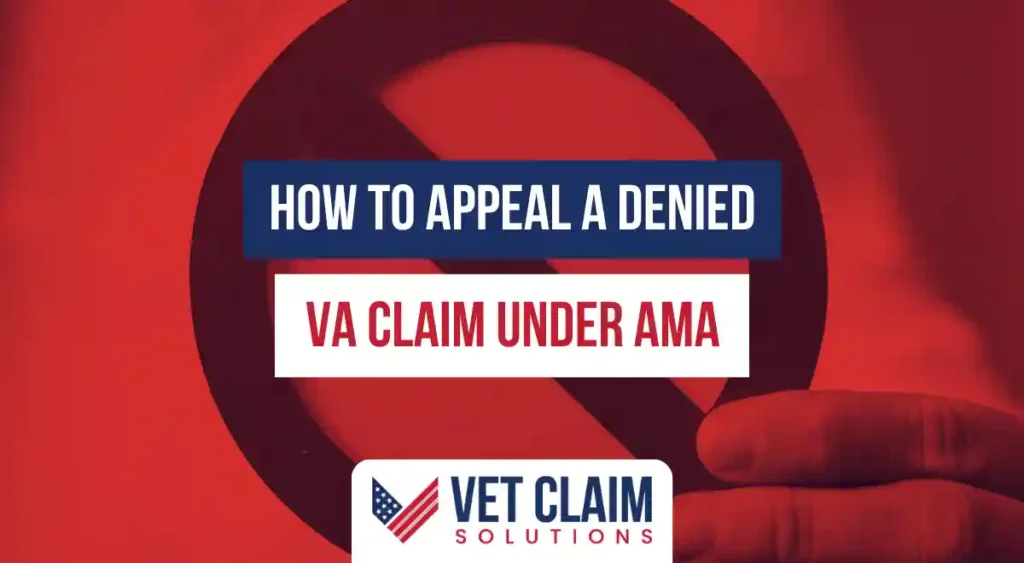Receiving a denied VA claim can feel like a punch to the gut. You served your country, you’re dealing with service-connected conditions, and then you get that letter; it’s a common story for many seeking disability benefits. It’s frustrating, and it can make you want to give up on your va disability claim. But please don’t; you have appeal options. This guide is here to explain How to Appeal a Denied VA Claim (2025 Guide) Explains the appeals process under AMA with HLR supplemental claims and board reviews. Understanding these pathways for your disability appeal is your first step towards potentially overturning that denial and securing your VA disability benefits. We will cover the essentials of the va appeals process, breaking it down so it feels less overwhelming as you consider your next steps with the Department of Veterans Affairs.

First Steps: Understanding Your VA Decision Letter
That letter from the Department of Veterans Affairs isn’t just bad news about your va claim; it’s a critical document. Before you even think about starting a va appeal, you need to sit down and carefully read your decision letter. It contains vital information for your next steps.
Look for a section usually called “Reasons for Decision.” This part tells you why the VA denied your disability claim. They might say they don’t have enough medical evidence, or perhaps they don’t see a clear link, often called a nexus, between your condition and your service. The letter will also list the evidence the VA reviewed. This is important because it shows you what they considered for your original claim and what might be missing.
Finally, your decision letter will outline your appeal options and, crucially, your deadline to file an appeal. This deadline is typically one year from the date on the letter for the va decision, so don’t put it off. Understanding this initial claim decision thoroughly is fundamental to a successful disability appeal.
The Appeals Modernization Act (AMA): Your Options Explained
A few years back, the VA changed how the va appeals process works. This system, known as the Appeals Modernization Act or AMA, gives veterans more choices and aims to speed things up for va appeals. It truly changed how veterans can approach a va decision they disagree with.
Instead of one long, winding path like the legacy appeal system, AMA gives you three main appeal options if you disagree with a claim decision. Understanding these options is very important because picking the right one for your specific situation can make a big difference in your va disability appeal. Let’s look at each appeal option available under the appeals modernization framework.

1. Higher-Level Review (HLR)
Think of a Higher-Level Review (HLR) as asking for a second opinion from a more experienced adjudicator, often a senior reviewer, at the VA. This higher-level reviewer was not involved in the previous decision on your va claim. You would choose this hlr option if you believe the VA made an error in reviewing the evidence they already had or misinterpreted the law in your original claim. When you choose hlr, you are asking for this fresh look.
With an HLR, you generally cannot submit new evidence. The senior VA reviewer looks at the same case file and information your original claims processor did. The hlr process is for situations where you feel the facts or law were applied incorrectly to your va disability claim. You can file for a higher level review by submitting VA Form 20-0996, which is the official hlr request va form.
One beneficial part of the HLR is the option for an informal conference. This is a phone call where you or your accredited representative can speak directly to the higher-level reviewer to point out what you think went wrong and why the previous decision should be changed. Preparing for this informal conference by outlining your specific points of disagreement can be very effective in helping the reviewer spot errors.
Outcomes of an HLR, or hlr decision, can vary. The reviewer might uphold the original decision, overturn it and grant the disability benefits, or identify an error that needs fixing, which might involve the VA gathering more information or correcting a procedural mistake. This decision review pathway offers a quicker way to potentially correct errors without submitting new evidence.
2. Supplemental Claim
The Supplemental Claim lane is your best appeal option if you have new evidence that you think will strengthen your va claim. This is a very common and often effective route for many veterans pursuing their disability benefits. Maybe your doctor recently wrote a strong medical opinion or a nexus letter, or you found old service medical records you didn’t submit with your initial claim.
This is what the Supplemental Claim, filed using VA Form 20-0995 (Decision Review Request: Supplemental Claim), is for. The key here is “new and relevant” evidence; submitting evidence that meets this standard is critical. “New” means the VA hasn’t seen this particular piece of evidence before for this specific disability claim. “Relevant” means it tends to prove or disprove something important to your claim, such as the severity of your condition or its connection to service.
You must submit this new and relevant evidence with your Supplemental Claim va form. The VA has a “duty to assist” you in gathering evidence for a Supplemental Claim in some situations. This could include helping you get federal records like military service records or VA medical records, which can be very helpful for your va disability appeal. If your new evidence is strong enough, the VA can issue a new rating decision, hopefully good news that grants your disability compensation.
3. Appeal to the Board of Veterans’ Appeals (BVA)
If you’re not satisfied with the outcome of an initial claim decision, a higher-level review (HLR decision), or a Supplemental Claim, you can take your case to the Board of Veterans’ Appeals (BVA). This involves a Veterans Law Judge (VLJ), an expert in veterans law, reviewing your disability appeal. This path is generally more formal than other review options.
You file a board appeal using VA Form 10182, Notice of Disagreement. The BVA offers three different review options, or dockets, and you pick the one that fits your situation best for your bva appeal. Choosing the correct docket is an important decision in the veterans’ appeals process:
- Direct Review: You choose this direct review option if you don’t want to submit any more evidence and don’t want a hearing. The Veterans Law Judge will review the same evidence the VA regional office had when making the previous decision. This is generally the fastest BVA appeal option available.
- Evidence Submission: With this appeal option, you can submit additional evidence directly to the Board for your disability appeal. You have 90 days from the date you submit your Notice of Disagreement (VA Form 10182) to get this new, relevant evidence to them. You do not have a hearing with this choice, but the law judge will review your new submissions.
- Hearing Request: This docket allows you to have a hearing with a Veterans Law Judge to discuss your va disability case. You can submit evidence at the hearing or within 90 days after it. Hearings can be held via video teleconference from your home or a local VA facility, in person at the Board in Washington, D.C., or sometimes a travel board hearing at your local regional office (though these are less common now). This option typically has the longest wait times due to the logistics of scheduling hearings with a law judge.
Board appeals, or bva appeals, can take a considerable amount of time, so patience is very important for veterans choosing this path. The Veterans Law Judge will issue a written decision that can grant your disability benefits, deny them, or remand your case. A remand means the case is sent back to the local VA regional office or the agency of original jurisdiction (AOJ) for more work, like gathering more evidence or correcting an error.

Key Steps in Appealing Your Denied VA Claim (2025)
Now that we’ve looked at the main appeal options under appeals modernization, let’s discuss practical steps for your va appeal. Knowing how to proceed after a va decision denies your disability benefits is essential. The following information, covering How to Appeal a Denied VA Claim (2025 Guide) Explains the appeals process under AMA with HLR supplemental claims and board reviews, should help you feel more prepared to challenge the claim decision.
Crucial Deadlines You Can’t Miss
This is perhaps the most important detail to remember: deadlines. Under the Appeals Modernization Act, you generally have one year from the date on your VA decision letter to choose one of the three main appeal options: a Higher-Level Review, a Supplemental Claim, or a Board Appeal to a Veterans Law Judge. Missing this one-year deadline for your va appeal can mean the rating decision becomes final.
You might still be able to reopen a va claim later by submitting new and relevant evidence through a Supplemental Claim. However, you could lose out on an earlier effective date for your disability compensation if the appeal is eventually successful. Don’t let that happen. Mark that date on your calendar, set reminders on your phone—whatever it takes because the Department of Veterans Affairs takes these deadlines very seriously.
Gathering Strong Evidence: Your Best Weapon
No matter which appeal lane you choose (except a direct review HLR or a direct review Board appeal where no new evidence is allowed), your evidence is what often wins va claims. If your initial claim was denied for lack of evidence, then finding more, or stronger, relevant evidence is your main task. What kind of evidence helps build a stronger case for your disability appeal?
- Medical Records: These include records from VA doctors, private physicians, hospitalizations, and specialist reports, including those for mental health conditions. Make sure they clearly document your diagnosis, the severity of your condition, and any ongoing treatment. Comprehensive medical records are fundamental to any va disability claim.
- Nexus Letters: This is very important for many va disability appeals. A nexus letter is a medical opinion from a healthcare professional that links your current medical condition to a specific event, injury, or illness during your military service. A well-written nexus letter from a qualified expert, detailing their rationale, can be incredibly persuasive for the claims processor or higher-level reviewer.
- Buddy Letters (Lay Statements): These are statements from people who know you and can discuss how your condition affects your daily life or what they observed during your service that relates to your disability claim. This could be from fellow service members, family, friends, or former employers. These statements need to be specific, credible, and ideally submitted on VA Form 21-10210 (Lay/Witness Statement).
- Service Records: Your official military personnel records (OMPF) and service medical records (SMRs) can contain vital information about your in-service injury, event, or illness. If something happened in service that supports your va claim, making sure the VA has these specific records is important. Sometimes, key information in these documents can help establish service connection for your disability rating.
Take time to gather everything that could support your va disability case; a complete case file is a strong asset. The more thorough you are in submitting evidence, the better your chances of receiving a favorable claim decision. When submitting evidence, especially personal medical records, be mindful of how you are sending them and keep copies for yourself. While the VA has its own va privacy policies for handling your information, it’s always good practice to manage your documents carefully. Consider creating a checklist of all potential evidence to make sure nothing is overlooked for your va appeal.
The Value of a Well-Developed Claim
Beyond just having evidence, how you present it to the Department of Veterans Affairs matters a great deal. A well-developed claim clearly explains what condition you’re claiming, how it’s connected to your service (the nexus), and how it impacts your daily life and ability to work. An organized case file makes it easier for the VA reviewer or senior reviewer to understand your arguments and the supporting documentation.
Sometimes a va disability claim is denied not because the condition isn’t legitimate, but because the connection to service wasn’t clearly established or the current severity wasn’t well documented. If you’re filing a Supplemental Claim, focus on how your new and relevant evidence fills the specific gaps identified in your denial letter from the regional office. Point out these connections clearly. Make their job easier to see why this new information changes the previous decision on your disability benefits.

Common Pitfalls to Avoid in Your VA Appeal
When pursuing a va appeal, being aware of common mistakes can save you time and improve your chances of a favorable outcome. One frequent issue is missing the one-year deadline to file an appeal after a claim decision. As mentioned, this is critical, so always note the date on your VA decision letter.
Another common pitfall is submitting a Supplemental Claim without truly “new and relevant” evidence. Simply re-submitting old evidence or arguing the same points without additional proof will likely lead to another denial. Your new evidence must address the reasons for the previous denial. For instance, if the denial was for lack of a medical opinion linking your condition to service, a strong nexus letter would be new and relevant.
Failing to fully understand the reason for the initial denial can also hinder your appeal. Your decision letter outlines why the VA denied your benefits; use this as a roadmap. If you choose a Higher-Level Review (HLR), remember you cannot submit new evidence; the HLR process is to spot errors in the VA’s review of the existing case file.
Not attending scheduled Compensation and Pension (C&P) exams is a significant error. These exams are often crucial for the VA to assess your current disability rating or service connection. Finally, some veterans don’t seek help when they need it. An accredited representative can guide you through the appeals modernization system and help you choose the best appeal option, whether it’s an HLR, supplemental claim, or board appeal, potentially preventing these common mistakes.
What Happens After You File Your Appeal?
Once you’ve submitted your va appeal, the waiting game begins again. The Department of Veterans Affairs will send you a letter confirming they received your appeal paperwork, such as your hlr request or supplemental claim va form. How long it takes to get a new claim decision depends heavily on the type of appeal option you filed and the current VA workload at the regional office or the Board.
Higher-Level Reviews (HLR) and Supplemental Claims are generally faster than Board Appeals, especially those BVA appeals requesting a hearing with a Veterans Law Judge. You can usually track the status of your appeal online through your VA.gov account, which can provide updates as your case is reviewed. It’s a good idea to check in periodically for any status changes or requests for information from the claims processor.
During the decision review process, the VA might contact you if they need more information or clarification on your submitted evidence. They might also schedule you for another Compensation and Pension (C&P) exam to assess your disability rating. If they do, it’s very important that you attend this exam; missing a C&P exam can lead to your va disability appeal being denied.
If Your Appeal is Still Denied by the Board
It’s a tough pill to swallow if even your Board appeal results in a denial of your disability benefits. But even then, it might not be the absolute end of the road for your veterans’ appeals journey. If the Board of Veterans’ Appeals (BVA) denies your va claim, your next appeal option is usually to the U.S. Court of Appeals for Veterans Claims (CAVC).
This is a federal court, and its process is different from VA appeals handled by the regional office or the BVA. The CAVC reviews the BVA’s decision for legal or factual errors made by the Veterans Law Judge; it does not typically re-evaluate the facts of your disability claim itself. You generally cannot submit new evidence at this stage.
Conclusion
Dealing with a denied VA claim is undeniably challenging and can be a real test of your patience. But remember, a denial of your va disability claim is not necessarily the final word. The Appeals Modernization Act provides specific pathways to challenge that decision, whether through a Higher-Level Review, a Supplemental Claim with new and relevant evidence, or a Board Appeal to a Veterans Law Judge.
Understanding your appeal options for How to Appeal a Denied VA Claim (2025 Guide) Explains the appeals process under AMA with HLR supplemental claims and board reviews. is the first and most critical step in continuing your pursuit of disability compensation. Gather your evidence thoroughly, pay close attention to deadlines for your va appeal, and do not hesitate to ask for help from accredited representatives who understand the va appeals process. You served, and you deserve to have your disability claim fairly considered and your case reviewed thoroughly.


